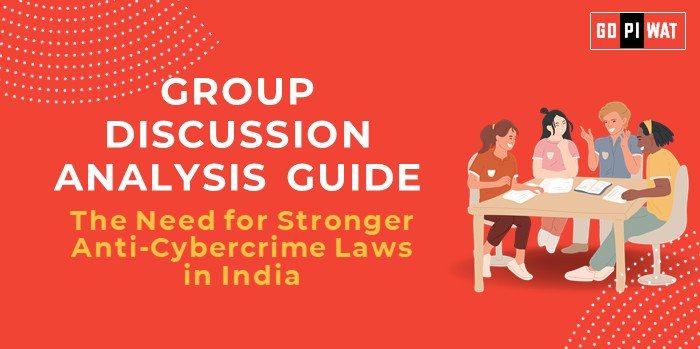📋 GD Analysis Guide: The Need for Stronger Anti-Cybercrime Laws in India
🌐 Introduction
- ⚖️ Opening Context: India’s rapid digital transformation, catalyzed by initiatives like Digital India, has made the country a global leader in digital adoption. However, this surge has also led to a steep rise in cybercrime, ranging from financial fraud to cyberterrorism, necessitating stronger legal safeguards.
- 📜 Topic Background: India recorded over 12.5 lakh cybercrime complaints in 2023, but conviction rates remain dismally low. Despite legislative frameworks like the Information Technology Act (2000), gaps in enforcement, technological evolution, and jurisdictional challenges have highlighted the urgent need for robust cybercrime laws.
📊 Quick Facts and Key Statistics
- 📂 Cybercrime Cases: 1.7 lakh cases registered in 2023, a 21% increase from 2022 (NCRB).
- 💰 Economic Losses: Estimated ₹1.25 lakh crore due to cyber fraud in 2023 (CERT-In).
- 🌐 Internet Penetration: 900 million users in India; high vulnerability to phishing and malware attacks (IAMAI).
- 📉 Global Ranking: India ranked 10th in the Global Cybersecurity Index (2022).
👥 Stakeholders and Their Roles
- 🏛️ Government: Policy formulation, enforcement, and international collaboration.
- 🏢 Private Sector: Strengthening digital infrastructure and promoting cybersecurity awareness.
- 👨👩👧👦 Citizens: Adopting safe online practices and reporting incidents.
- 🌍 International Bodies: Sharing best practices and aiding cross-border investigations.
🏆 Achievements and Challenges
✨ Achievements:
- 📈 Improved Cyber Reporting: Platforms like the Cyber Crime Reporting Portal have eased complaint lodging.
- 📚 Capacity Building: Training for law enforcement under CERT-In initiatives.
- 🌍 Global Engagements: Participation in global frameworks like the Budapest Convention.
⚠️ Challenges:
- 📜 Weak Legal Frameworks: Outdated laws inadequately address emerging threats like AI-driven cybercrime.
- 📉 Low Conviction Rates: Bureaucratic delays and lack of expertise hinder justice delivery.
- 🌾 Rural Vulnerability: Limited digital literacy exposes rural users to cyber fraud.
📖 Case Studies:
- 💻 AIIMS Cyberattack (2022): Highlighted healthcare sector vulnerabilities in India.
🗣️ Structured Arguments for Discussion
- ✅ Supporting Stance: “Stronger laws will build citizen trust in digital platforms and promote economic growth through secure digital transactions.”
- ❌ Opposing Stance: “Overregulation might stifle innovation and increase compliance costs for startups.”
- ⚖️ Balanced Perspective: “Robust laws, complemented by tech-driven enforcement, can address challenges while fostering innovation.”
💡 Effective Discussion Approaches
✨ Opening Approaches:
- 💻 Case Example: Quote the AIIMS cyberattack to illustrate critical gaps.
- 📊 Highlight Economic Losses: “India lost ₹1.25 lakh crore to cyber fraud in 2023, underscoring the need for robust safeguards.”
🔄 Counter-Argument Handling:
- 🌍 Present international examples, e.g., Estonia’s success with e-governance despite strict laws.
- 📡 Emphasize technology-based solutions, such as AI-driven monitoring systems.
⚡ Strategic Analysis of Strengths and Weaknesses
- 💪 Strengths: Growing digital infrastructure, government commitment.
- 🚫 Weaknesses: Weak enforcement, lack of specialized legal frameworks.
- 🚀 Opportunities: AI/ML integration, international collaboration.
- ⚠️ Threats: Evolving cyber threats, global espionage risks.
📚 Connecting with B-School Applications
- 🏢 Real-World Applications:
- 📊 Cybersecurity laws relate to governance, digital transformation, and risk management themes in management projects.
- 🤔 Sample Interview Questions:
- ⚖️ “How can India improve its global cybersecurity ranking?”
- 📢 “Discuss the balance between digital innovation and regulation.”
- 💡 Insights for Students:
- 📈 Explore legal-tech startups.
- 🖥️ Study the role of cybersecurity in corporate governance.


